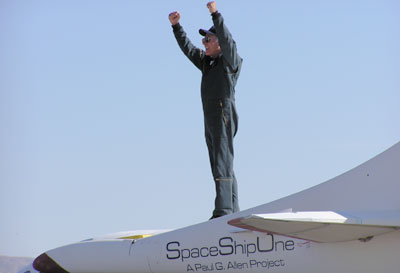A new movement or a new industry?by Taylor Dinerman
|
| These companies are not trying to change the world. Instead, they are trying to make a profit. |
Of course politics will be involved, as it is in any human endeavor. The presence of Patti Grace Smith, the FAA’s associate administrator for commercial space transportation, in Mojave showed that even a purely private project such as SpaceShipOne still needs to be licensed and regulated by the government. As long as these new companies have to operate in the real capitalist economy of 21st century America their primary function is to make money. Unlike the civil rights “movement” or the conservative “movement” or the environmental “movement”, these companies are not trying to change the world. Instead, they are trying to make a profit. In doing so they will change the relationship between humanity and near-Earth space, but their function is to make money and provide jobs.
What we are seeing is the birth of a new industry, one that carries with it the hopes and dreams of space advocates all over America and the world. However, we should not confuse the legitimate desire for a new spacefaring civilization with the equally legitimate goal of building return on investment. Without the crutch of government subsidies or big contracts, this new industry has to compete out there in the cold hard world of the free market. There are tens or hundreds of thousands of companies and products clamoring for a piece of somebody’s disposable income. Soon Rutan and the other space tourism pioneers are going to be trying to sell tickets to a public that is overwhelmed with choices on how to spend not only their money but also their precious leisure time.
Passenger-carrying suborbital flight is going to be the most popular and widespread form of space tourism for a long time to come. Within a decade it will be as popular and probably as banal as recreational skydiving. A thrill that once was only confined to the military and to a few hobbyists and experts is now a recognized and regulated sport, similar is some ways to scuba diving. Being strapped into a rocket that someone else is flying can scarcely be considered a sport, but it is a leisure activity that will attract the bold and the brave for decades to come.
| While investors may be willing to make a contribution to a movement, they will be extremely reluctant to invest in anything other than an industry. |
For this new industry to truly thrive these vehicles will have to reach orbit. It will not be easy to get from X Prize-class craft like SpaceShipOne to a genuine orbital spaceplane. A genuine step-by-step process, with the companies or teams trying to outdo one another, is what it will take. In this respect the X Prize Cup project, to be held in New Mexico, will provide a locus for these competitive developments. It will be interesting to see if the anticipated improvements in performance come more from large investments for small incremental gains, or will they come from strokes of genius such as we have come to expect from Burt Rutan.
The most important thing is that Tumlinson has it right. “The door has been blown off its hinges.” Everything has changed, but what has not changed is the need for investors to see not only the huge potential returns from this new industry, but also they need to be reassured that they are putting their money into something solid and well thought out. While they may be willing to make a contribution to a movement, they will be extremely reluctant to invest in anything other than an industry.
